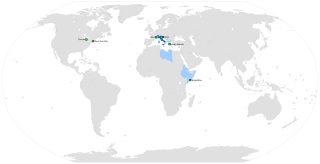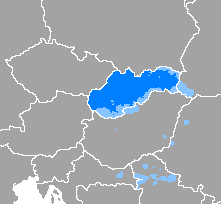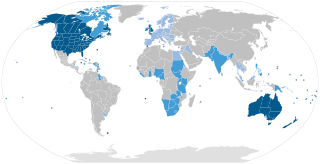
Arabic is a Semitic language spoken primarily across the Arab world. Having emerged in the 1st century, it is named after the Arab people; the term "Arab" was initially used to describe those living in the Arabian Peninsula, as perceived by geographers from ancient Greece.

Bulgarian is an Eastern South Slavic language spoken in Southeast Europe, primarily in Bulgaria. It is the language of the Bulgarians.

The Germanic languages are a branch of the Indo-European language family spoken natively by a population of about 515 million people mainly in Europe, North America, Oceania and Southern Africa. The most widely spoken Germanic language, English, is also the world's most widely spoken language with an estimated 2 billion speakers. All Germanic languages are derived from Proto-Germanic, spoken in Iron Age Scandinavia.
Hawaiian is a Polynesian language of the Austronesian language family that takes its name from Hawaiʻi, the largest island in the tropical North Pacific archipelago where it developed. Hawaiian, along with English, is an official language of the US state of Hawaii. King Kamehameha III established the first Hawaiian-language constitution in 1839 and 1840.

Italian is a Romance language of the Indo-European language family that evolved from the Vulgar Latin of the Roman Empire. Together with Sardinian, Italian is the least divergent language from Latin. Spoken by about 85 million people (2022), Italian is an official language in Italy, Switzerland, San Marino, and Vatican City. It has official minority status in Croatia and in some areas of Slovenian Istria.

The International Phonetic Alphabet (IPA) is an alphabetic system of phonetic notation based primarily on the Latin script. It was devised by the International Phonetic Association in the late 19th century as a standardized representation of speech sounds in written form. The IPA is used by lexicographers, foreign language students and teachers, linguists, speech–language pathologists, singers, actors, constructed language creators, and translators.

The Romance languages, sometimes referred to as Latin languages or Neo-Latin languages, are various modern languages that evolved from Late Latin and its spoken form, often called Vulgar Latin. They are the only extant subgroup of the Italic languages in the Indo-European language family.

Slovak[ˈslɔʋentʂina], [ˈslɔʋenski ˈjazik] is a West Slavic language of the Czech–Slovak group, written in Latin script. It is part of the Indo-European language family, and is one of the Slavic languages, which are part of the larger Balto-Slavic branch. Spoken by approximately 5 million people as a native language, primarily ethnic Slovaks, it serves as the official language of Slovakia and one of the 24 official languages of the European Union.

Y, or y, is the twenty-fifth and penultimate letter of the Latin alphabet, used in the modern English alphabet, the alphabets of other western European languages and others worldwide. According to some authorities, it is the sixth vowel letter of the English alphabet. In the English writing system, it mostly represents a vowel and seldom a consonant, and in other orthographies it may represent a vowel or a consonant. Its name in English is wye, plural wyes.
Some Buddhist terms and concepts lack direct translations into English that cover the breadth of the original term. Below are given a number of important Buddhist terms, short definitions, and the languages in which they appear. In this list, an attempt has been made to organize terms by their original form and give translations and synonyms in other languages along with the definition.
Drehu is an Austronesian language mostly spoken on Lifou Island, Loyalty Islands, New Caledonia. It has about twelve-thousand fluent speakers and the status of a French regional language. This status means that pupils can take it as an optional topic for the baccalauréat in New Caledonia itself or French mainland. It has been also taught at the Institut national des langues et civilisations orientales (INALCO) in Paris since 1973 and at the University of New CaledoniaArchived 2007-10-12 at the Wayback Machine since 2000. As for other Kanak languages, Drehu is now regulated by the "Académie des langues kanak", officially founded in 2007.

Tucanoan is a language family of Colombia, Brazil, Ecuador, and Peru.

The Latin script, also known as Roman script, is an alphabetic writing system based on the letters of the classical Latin alphabet, derived from a form of the Greek alphabet which was in use in the ancient Greek city of Cumae, in southern Italy. It was adopted by the Etruscans and subsequently by the Romans. Several Latin-script alphabets exist, which differ in graphemes, collation and phonetic values from the classical Latin alphabet.

English is a West Germanic language in the Indo-European language family, with its earliest forms spoken by the inhabitants of early medieval England. It is named after the Angles, one of the ancient Germanic peoples that migrated to the island of Great Britain. Existing on a dialect continuum with Scots and then most closely related to the Low German and Frisian languages, English is genealogically Germanic. However, its vocabulary also shows major influences from French and Latin, plus some grammar and a small amount of core vocabulary influenced by Old Norse. Speakers of English are called Anglophones.

Finnish is a Uralic language of the Finnic branch, spoken by the majority of the population in Finland and by ethnic Finns outside of Finland. Finnish is one of the two official languages of Finland. In Sweden, both Finnish and Meänkieli are official minority languages. The Kven language, which like Meänkieli is mutually intelligible with Finnish, is spoken in the Norwegian county Troms og Finnmark by a minority group of Finnish descent.
Sura language may refer to:

Meeting of the Waters is the ninth EP by American experimental pop band Animal Collective, released first on Record Store Day, April 22, 2017. It is the second extended play released by the band in 2017. The EP was recorded live on location in the Amazon Rainforest. It is notable for containing many recordings of animal calls and some sounds being recorded underwater, as well as being documented in the Viceland series Earth Works. This is the band's first release to feature only Avey Tare and Geologist and currently the only to feature this particular lineup of the collective.

A transformer is a deep learning model that adopts the mechanism of self-attention, differentially weighting the significance of each part of the input data. It is used primarily in the fields of natural language processing (NLP) and computer vision (CV).













